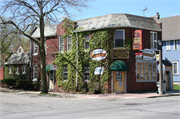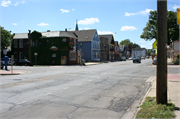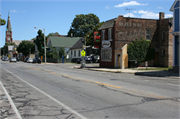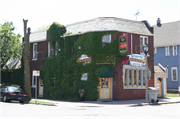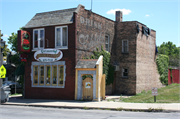Property Record
2501 W GREENFIELD AVE
Architecture and History Inventory
| Historic Name: | Mary Patock Tavern |
|---|---|
| Other Name: | Coventry Inn |
| Contributing: | |
| Reference Number: | 99749 |
| Location (Address): | 2501 W GREENFIELD AVE |
|---|---|
| County: | Milwaukee |
| City: | Milwaukee |
| Township/Village: | |
| Unincorporated Community: | |
| Town: | |
| Range: | |
| Direction: | |
| Section: | |
| Quarter Section: | |
| Quarter/Quarter Section: |
| Year Built: | 1904 |
|---|---|
| Additions: | 1935 |
| Survey Date: | 19852015 |
| Historic Use: | tavern/bar |
| Architectural Style: | English Revival Styles |
| Structural System: | |
| Wall Material: | Brick |
| Architect: | Charles Lesser (1904); Mark Frank Pfaller (1935) |
| Other Buildings On Site: | Y |
| Demolished?: | No |
| Demolished Date: |
| National/State Register Listing Name: | Not listed |
|---|---|
| National Register Listing Date: | |
| State Register Listing Date: |
| Additional Information: | A 'site file' exists for this property. It contains additional information such as correspondence, newspaper clippings, or historical information. It is a public record and may be viewed in person at the Wisconsin Historical Society, State Historic Preservation Office. 2015- "Built in 1904, this highly intact, brick, Tudor Revival-style tavern took on its present appearance in 1935. Situated on a corner lot, the entrance to this two-story building is located on a canted corner. An ironwork balconet underlines a second-story window. The north facade faces W. Greenfield Avenue and on the first level displays a row of five diamond-paned, leaded-glass casement windows set within a stone surround. Two additional sets of square-paned casement windows are on the second floor. The eastern elevation consists of diamond-paned, double-hung sashes on the first floor and square-paned examples on the second. A slate-covered pent roof is interrupted on the east side by a raised gabled parapet that is visible on these two facades. A one-story wing topped with a slate-covered pent roof projects from the rear (south) facade. The east elevation retains a tile mosaic of the Schlitz Brewing Company and a faded painted advertisement for the same on the western acade. The intact to the 1930s interior features a bar area (with original bar and backbar) and a separate dining room. Wooden board paneling and wainscoting are evident. Designed by Charles Lesser, the Schlitz Brewing Company in 1904 built this tavern and it was operated by a succession of people until it closed due to Prohibition. It was sold in 1922 to Frank and Mary Patock who used the building to sell soft drinks. Upon the repeal of Prohibition, Mary Patock hired architect Mark F. Pfaller to redesign the building's exterior in 1935 into its present Tudor Revival-style appearance. Renamed the Coventry Inn in the 1940s, Patock sold the tavern in 1947 to Walter and Rose Orlowski. The tavern remained the Coventry Inn until 1990 when it was sold to Paul Westin who renamed the business the Benjamin Briggs Pub. Today, it is a Mexican restaurant named El Canaveral. It was designated a City of Milwaukee landmark in 2010." - "W. Greenfield Ave, S 35th St (west) to S. Cesar Chavez Dr (east)", WISDot #2230-00-04, Prepared by Heritage Research, Ltd. (Faltinson), (2015). The Schlitz Brewing Company on 22 September 1891 purchased an empty lot at the corner of present-day S. 25th Street and W. Greenfield Avenue for $2400. The Schlitz Brewing Company, like its competitors Pabst, Blatz and Miller, began the practice of buying up corner lots in the 1880s and a Milwaukee Sentinel article from 26 April 1885 indicated that the three major breweries (Schlitz, Best later known as Pabst, and Blatz) had purchased around 200 corner lots in the past year alone. The article went on to say that the fact “that there should be room for a saloon for every 130 inhabitants (including men, women and children) has given the city the name of being the saloonkeeper’s paradise.” The article continued: "Is hardly possible, however, that all of these saloons could be profitably continued were it not for the backing of the brewers. The brewers have invested an enormous aggregate of capital in the business of brewing beer, and have a vital interest in having the demand for beer kept up. Within the past two years the export trade has been affected by a more active competition, and in order to utilize the full strength of their productive facilities, local brewers have seen the need of maintaining the home trade.” Rather than merely supplying stock and fixtures to saloonkeepers who might otherwise prove untrustworthy or unbusinesslike, the breweries took it upon themselves to erect their own tavern buildings with the result that “[I]t secures the erection of better buildings in place of the wretched structures occupied by the proprietors of low grogeries, and better order will be maintained.” All this development was viewed with skepticism by the paper which commented that saloons sites were being acquired even in the better residence portions of the city and “every property owner knows that they do not enhance the value of his adjoining property, and although he may be a good patron of the saloon, he does not care to have it for his next door neighbor.” As the Milwaukee Sentinel article forecast, the various breweries began construction of corner saloons in the 1880s. To their credit, the breweries contracted with some of the best architects of the day. In some instances, a brewery would contract with one particular architect. In other instances, a brewery would have several designers under contract, each of whom had a specialty or part of the city where he was well established. The buildings erected were sometimes the focal points of their neighborhoods and made drinking more respectable. Many of the buildings were constructed of masonry materials, more expensive and longer lasting, although some were frame buildings. Schlitz contracted with Charles Kirchhoff Jr. to design some of the most famous buildings of the city including the Schlitz Palm Garden (no longer extant) downtown. Kirchhoff with his later partner Thomas Rose became the architects of choice for the personal residences and investment buildings erected by members of the Uihlein family, owners of the Schlitz concern. Schlitz Brewing Company also contracted with Charles L. Lesser to design a host of taverns for locations on the city’s south side. As this end of Greenfield Avenue developed slowly, with buildings gradually moving west along the corridor, Schlitz saw no need to immediately build a tavern on the two lots it purchased in 1891. In fact, this block saw only three buildings constructed in the 1890s. Schlitz took out the permit to build the present building on March 9, 1904, and it was the first building constructed on this block after the turn of the 20th century. The building was a modest two-story solid masonry structure with the entrance at the canted corner. The proprietors who ran the tavern under Schlitz’s ownership included Henry Raasch (1905-1906), Joseph Zdroyk (1907-1908), Louis Mikulecky (1909), Joseph and Helen Zdroyk, later a widow (1910-1911), William Schaefer (1912-1920) listing in 1920 is for a soft drink parlor. The surnames of the proprietors show the mix of German and Polish ethnicity in the neighborhood. As was typical for the day, the saloonkeepers lived in the apartment upstairs from the tavern. With the coming of Prohibition, the breweries were forced to divest themselves of their real estate. Many of the Schlitz taverns were transferred to Robert A. Uihlein before sale to other owners. In this instance, the title was transferred to Robert A. Uihlein on April 15, 1920. On February 27, 1922, Uihlein sold the building to Frank and Mary Patock. The deeds reflect that the building came with the bar and saloon fixtures but that they were not included in the sale price and could be removed by Schlitz at any time. Since alcohol was illegal, Frank and Mary Patock, who operated a soft drink parlor on the premises although oral history indicates there was still alcohol to be had (they lived in the upstairs apartment). Frank Patock died on March 14, 1923, and Mary had other individuals run the business: Leo Bilot (1923-1924); Clara New (Nee Warras) (1925-1930). Mary had a 20 foot by 30 foot concrete block garage built at the rear of the property in 1924. Mary Patock retained ownership of the property and after the repeal of Prohibition she obtained an occupancy permit to operate as a tavern on October 23, 1934. She is shown as the proprietor on the permit. She subsequently contracted with local architect Mark F. Pfaller to remodel the building. How she chose Pfaller is unknown, however, Pfaller’s father was living a block away at the time and had once operated a tavern at the corner of Greenfield and Layton Boulevard so there may have been social connections. The permit for the remodeling was taken out on April 4, 1935, and was estimated to cost $3,600. Building plans indicate that the remodeling gave an entirely new look to the building. New leaded glass windows were installed. Square panes were used on the upper floor and toward the rear on the first floor. The Greenfield Avenue first-floor windows feature diamond-paned leaded glass of amber color and the window opening was surrounded by stone trim. A pent roof was added along the Greenfield Avenue and S. 25th Street elevations and it was clad with slate shingles. A decorative iron balconet was installed below the corner window and a stone surround with modified Tudor arch was created at the canted corner. The new main entrance door was designed to have a vertical plank door with a small square window, very much in keeping with Tudor Revival residential architecture of the 1920s and 1930s. A gable was added to the east elevation. A Tudor arched doorway was created at the east elevation. A new one-story addition was constructed at the rear intended for a dining room. The new English look to the tavern was in keeping with the stylistic trends of the mid-1930s. The new look also gave a distinct character to the building and distinguished it from the traditional brewery taverns that populated Milwaukee’s neighborhoods. Interestingly, on the sign shown on the building plans, the name of the business is not distinguishable but the word “INN” reads clearly. It is apparent that Mary Patock was remodeling to reflect a change in the character of the business to include dining and perhaps she had remodeled for a tenant who would be leasing the premises. One historic tie to the building’s origins was kept for posterity, the old Schlitz mosaic on the east wall of the building. It may have been around this time that the tavern was leased to John Preiss. He is cited in oral history but does not show up in the city directories. It is said that Preiss’s son-in-law was from England and the remodeled tavern reminded him of those he had seen in Coventry, England. The name Coventry Inn resulted. The name Coventry Inn first appears associated with this building in the 1942 city directory. Mary Patock sold the building to Frank and Sylvia Wiskowski on January 23, 1947 and the Wiskowskis turned around and sold it to Walter and Rose Orlowski on June 12, 1947. The Orlowskis would live in the upstairs apartment and run the Coventry Inn for eight years. The Orlowskis sold the premises to George R. and Phyllis A. Schauer on August 15, 1955 and they maintained the name Coventry Inn. The Schauers sold the building to Paul Westin and his wife Cynthia Hein on June 11, 1990. They ran the business as Benjamin Briggs Pub for approximately twelve years. He operated a summer beer garden in the back yard. Westin sold the building to MPC Investments on April 9, 2002. MPC sold the building to Neuberg Real Estate Holdings on April 5, 2005. The property subsequently went into foreclosure in 2008. Mortgage holder Tri City National Bank acquired the property in a sheriff’s sale on December 15, 2008. The current owner, Raul Varela Rodriguez purchased the building on March 26, 2009 and currently operates the building as a restaurant, El Canaveral. |
|---|---|
| Bibliographic References: | A City of Milwaukee landmark. See Historic Designation Report, available online. Original permit dated 9 March 1904; permit for remodeling to current appearance, 4 April 1935. City directories. |
| Wisconsin Architecture and History Inventory, State Historic Preservation Office, Wisconsin Historical Society, Madison, Wisconsin |

